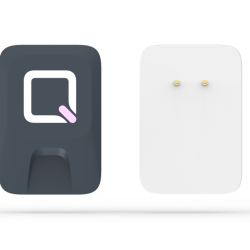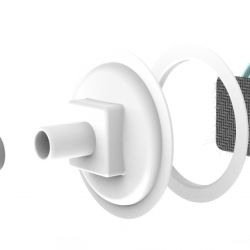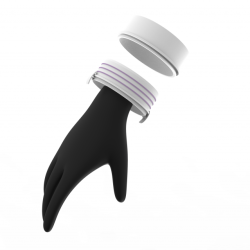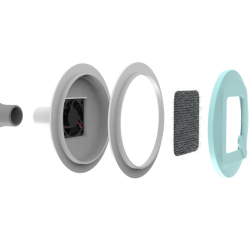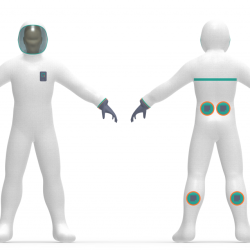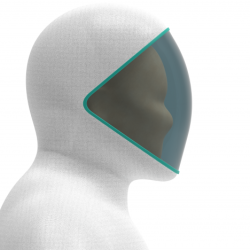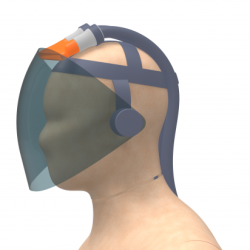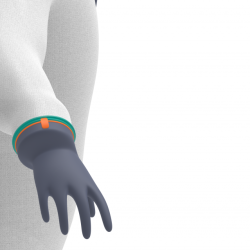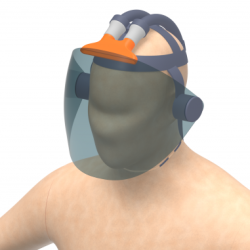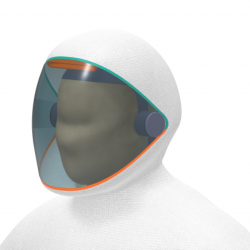Q-Suit Essential Requirements
1. Barrier to Entry, Barrier to Exit (BEBE).
This means complete filtration–all air coming into the suit and going out of the suit is filtered. Thus, ‘nothing gets in, nothing gets out’ in terms of contaminants. Regarding respiratory viral transmission, the carrier may wear the suit without contaminating persons nearby via exhalation, and a non-carrier may wear the suit near carriers and not inhale their exhaled viral particles.
2. Face to Face Exposure Elimination (FEFE).
This refers to the suit’s openings (ventilator fan entrance openings, ventilator exit openings and suit zipper) are all on the rear of the suit, effectively eliminating the main pathways of respiratory viral transmission due to face-to-face contact.
3. Positive Pressure:
The suit, when ventilated by its two fans will provide 0.5-1 psid differential pressure above ambient. This largely eliminates the ability of viral material to enter the suit through even microscopic openings at the zipper.
4. Ease of Donning and Doffing:
The suit is roomy and can be donned and doffed quickly (less than ~1 minute). A single horizontal entrance zipper on the rear of the suit (further eliminating facial / frontal exposure) similar to wet suits makes it easy to put on and take it off without assistance.
5. Light Weight / Low Profile:
The suit is light in weight (TBD kg) and its hardware items (hoses, ventilator fans, filter frames) are functional but particularly low-profile from a human performance ‘fit and function’ perspective. This makes the suit distinctively easy to wear for several hours at a time, and much more comfortable than comparable PPE.
6. Sterilization:
The Q-Suit is compatible with one or more Planetary ProTech approved sterilization systems (TBD) which eliminates pathogens at a rate that meets user requirements. An example of sterilization technology includes Halosil’s fogging system which employs a hydrogen peroxide disinfectant formula which is proven to kill 99.9999% of C. difficile spores, along with a broad range of other pathogens.
7. Filters:
Initial filters employed are redundant super HEPA with the capability of stopping particles 0.1 µm and above (the coronavirus is 0.125 µm). These filters are long lasting (>1 year) and will survive the life of the suit. For differing contaminant environments, user confidence and for adaptability to other filtration requirements, the filters are field replaceable.
8. Redundancy:
All critical systems are redundant and automatically fail-over and alert the user, this includes fans, filters, umbilical and batteries.
9. Reusability:
Q-suit is reusable and can be supplied with an externally worn disposable apron for an added layer of exterior protection.
10. Cost:
estimates indicate low unit cost. Component bill of material costs for the prototype Q-suits have totaled less than $100.
Q-Suit Design Features
These notes indicate the features of the design that must be retained in order to retain the suit’s overall functions listed above. Whatever fabrication methods, materials or hardware are used to substitute for those used in the Reference Garment, they should not interfere with these functions. The following design elements of the Q-Suit are discussed in no particular order.
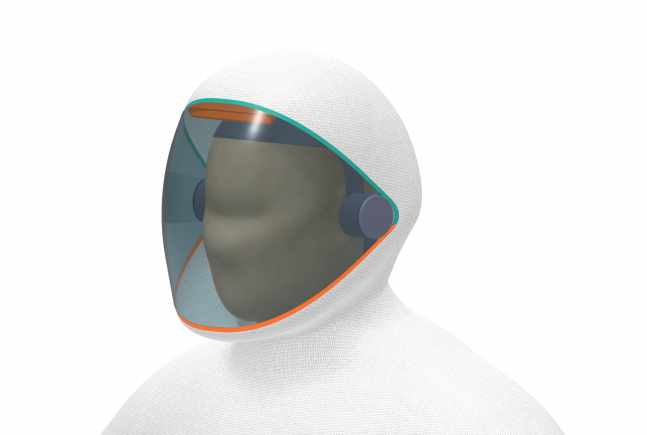
Sizing:
The Q-Suit is a gender-neutral design that comes in a range of sizes (S, M, L, XL).
Bubble Visor:
The function of the bubble visor is to provide a roomier feel in the hood area, and to provide the ability to look downward while standing; a flat visor severely restricts both of these. The ellipsoid bubble visor should be roughly 10 inches in diameter, 5 or more inches deep, and provide a wide (>180 degree) field of view without restraining head movement. It is made of a non-shattering material such as polycarbonate. It accepts antifog wipe chemicals on the inside; normally these are some variety of a non-irritating surfactant.
Facial Lighting:
Dimmable LED lighting around the periphery of the bubble visor is provided to illuminate the wearer’s face for convenience and improved patient interactions.

Display and Warning System:
TBD lights (e.g. flashing facial lighting), sounds or other warnings alert the wearer to Q-Suit status and error conditions which may include deficient battery charge, improper fan operation and elevated CO2 levels.
Entry Zipper:
The function of the rear zipper is to allow entrance and exit from the suit carried out by a single person (without assistance). The zipper need not be gastight; modern rainproof zippers for outdoor clothing feature closely sealing lips that are largely rainproof and in the case of the Q-suit, retain sufficient suit gas (air) to maintain the design feature of being positive-pressure.
Glove Cuffs:
The functions of the glove cuffs are (a) to provide a rigid ring for repeated mounting / dismounting of surgical or other similar gloves, and (b) to allow space at the wrist where circulated suit air can reach the hands, keeping them cooler and more comfortable than if the gloves were tight at the wrists. Any plastic ring will do; but it should be roughly 4″ in outer diameter, 3″ in depth (cylinder length) and should be mounted at a point on the sleeve corresponding not to the wrist, but several inches above the wrist, to allow mounting of long, gauntlet-style surgical or comparable gloves.
Suit Ventilators:
Suit Exit Filters:
The function of the two identical exit filters is to ensure that air exhaled in the suit is filtered before exiting the suit. Their position on the rear of the lower leg reduces facial / frontal exposure, as noted above, and also allows sitting with the thighs on a chair without blocking the exit filter. Provided are sample frames; we have experimented with both screw-in and flat, slide-in filter frames; in production, any reasonable method of attaching the suit frame and its filter frame will be acceptable. In all cases, a gasket or other gastight seal is needed at the frame-coverall interface.
Umbilical Hoses:
The function of the dual umbilical hoses is to move ~6 cfm filtered air from the intake ventilators to the upper area of the bubble visor. Currently these are velcroed into place, but other methods of securing the hoses may be entertained. The hoses are selected to be roughly 1″ in inner diameter, important for conveying enough air for comfortable breathing. They should be pliable enough to allow free movement of the torso and neck, but ribbed with a stiffener (as in the reference garment) to prevent collapse if pressed or bumped. The two hoses are important to keep separate so that the complete independence of the two ventilator functions is maintained; this is for suit safety via redundancy in this suit element. Whatever the final disposition of the hoses, they must deliver the filtered air so that it exits the hoses and immediately contacts the upper, inner surface of the bubble visor; this ensures that the clean air washes down the front of the visor, helping to keep it fog-free, and, as importantly, the air movement immediately carries exhaled CO2 (and viral contaminants) down into the lower part of the suit at each exhalation. This way, continued air flow keeps the visor fog-free and the helmet/hood area free of CO2 and contaminants.
Ventilator Power Unit & Accessories:
The ventilators are powered by a 12v DC battery cell and actuated with an on/off switch. A low-drawing LED light turns on when the ventilators are powered to indicate that power is flowing and battery charge status. The battery is currently a Tenergy NiMH 12V 2000mAh Battery Pack; a rechargeable model should be used, incorporating a gastight fitting for a recharging plug, so that the battery can be recharged from the exterior without taking off the suit. Alternatives, such as separate batteries, power flow LED indicators, and switches for each ventilator, may be entertained. The position of the ventilator on/off switch in the upper center of the chest has been decided on to keep the wrists free of buttons (which might be easily accidentally bumped on/off) and to eliminate the need of wiring in the sleeves, which would be a weakness in terms of wires being strained and breaking when people don or doff the suit. Simply wiring the ventilators from the chest down the front of the torso and then to the rear sides of the torso eliminates all of these issues. Currently, wiring is largely housed in nylon / velcro sleeves inside the garment.
Booties:
The function of the booties is to enclose the foot. These are designed large enough to fit over shoes, so shoes do not have to be removed when wearing the suit. Some sort of traction surface, e.g. rubber, is needed on the soles of the booties. A drawcord at roughly ankle height draws in excess material around the foot / shoe.
Rapid Outbreak Response (ROR)
We were challenged to think about “What will the world look like in the post-Covid era?” That led to a number of follow-on questions: How should the world respond to the inevitable outbreak of the next contagious disease? How can we minimize the catastrophic effects of rolling lockdowns around the World? We realized Planetary ProTech’s unique approach to bio-isolation can play an important role in answering these questions and more.
“While biological events may be inevitable, their level of impact on our Country is not.”
Dr. Michael Osterholm
Epidemiologist, Regents Professor, and Director
Center for Infectious Disease Research and Policy at the University of Minnesota
Deadliest Enemy: Our War Against Deadly Germs (pp. 275)
In spite of outbreaks of dangerous and contagious biological threats in recent years, the world remains unprepared to meet the challenges ahead. The global community’s recent experience with Covid-19 taught us the status quo with regard to preparedness is unacceptable.
Since the 1960’s, NASA developed technologies to protect Earth from unknown biological hazards which might be brought back by returning astronauts. The current Covid-19 pandemic has made it abundantly clear that we need to harvest and apply these lessons to significantly mitigate the risk of contagions of unknown origin. Resources need to be available immediately and at scale.
The World urgently needs a regional, continental and global response service that can spring to action in the face of outbreaks of unknown viral origin, including, but not limited to Swine Flu, Bird Flu, SARS, Ebola, and the multitude of Covid strains.
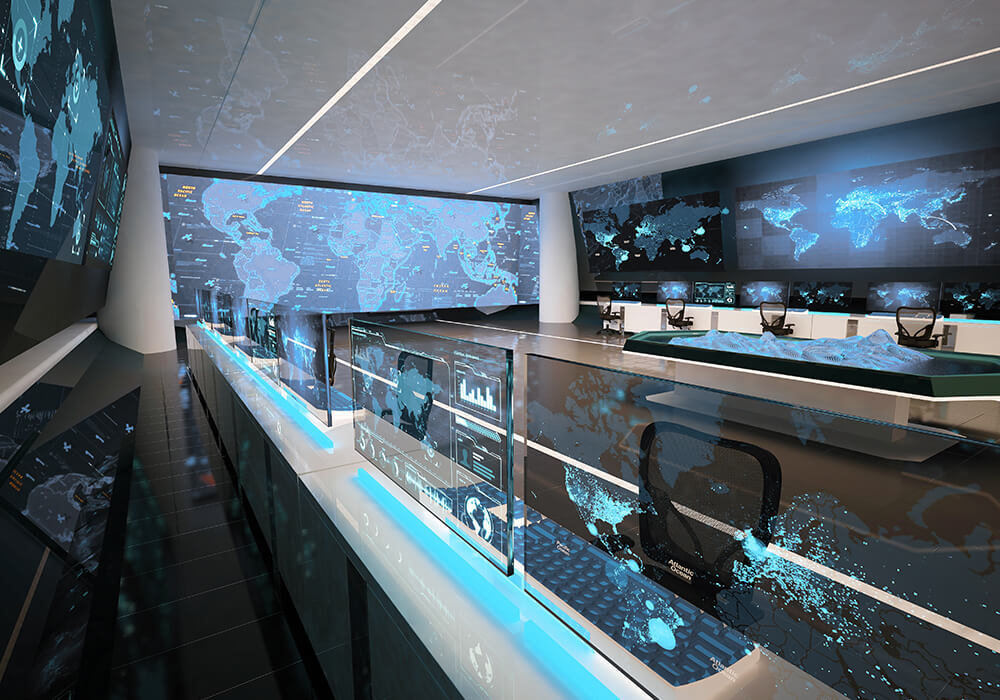
Planetary ProTech LLC and its network of collaborative partners is ideally positioned to develop and deploy a Rapid Outbreak Response (ROR) service comprised of elements tailored to the needs of subscribing private and public clients.
Planetary ProTech’s Global Rapid Response Service (GRRS) can be configured to include:
- Pre-stocked supplies of QSuit 0.1 micron two-way bio-isolation garments which supply the wearer filtered incoming air and blocks asymptomatic spread by filtering outgoing air.
- A global logistics capability with 12-hour regional, 24-hour continental and 48-hour global response to an outbreak and delivery to point of need.
- Forward operating base support including supplementary power and mobile command center communications and accommodations.
- Large governmental clients can opt for Full Membership services based on an annual fee (supplies pre-stocked in-country with 12-hour response).
- Smaller, less financially capable governmental clients can opt for Associate Membership with a lesser annual fee, or on-demand service fee, where response times are slightly longer as nearest stocks may be on location at a nearby Full Member .
- Private enterprise level clients can opt for Limited Membership with a one-off registration fee and an on-demand top up service if required.
A Full Membership consists of all the following elements:
- Standby supplies stocked and pre-positioned at in-country warehouse and distribution centers, typically serving a radius of 300 miles or less.
- Each warehouse built to a defined specification like Amazon distribution centers.
- All distribution centers staffed with identical teams and operating to a single specification.
- Initial stock of one Q.Suit per thousand of population.
- Sterilization units pre-stocked at the rate of one per one hundred suits.
- Supplies also include a stockpile of Q.Helmets, Q.Comms, Q.Masks, Sterilization Units and Respirators.
- Video training in local language and response team trained to train in-location.
Following a ROR deployment, or at expiry dates where applicable, each site is returned to a ready state by being restocked with equipment.
U.S. based Global Operations Center to:
- Coordinate ROR deployments and resupply logistics.
- Collaborate with governmental- and non-governmental health organizations, scientists, virologists and laboratories worldwide.
- Maintain and deploy global response.
Quarantine (“Q”) Equipment
- Q.Suit – Fully enclosed lightweight, low cost bio-isolation system that filters incoming and outgoing air to provide immediate protection for frontline healthcare workers and researchers during the all-important period of uncertainty… before the method of transmission and lethality is clearly understood.
- Q.Comms – Optional wireless comms kit built in that' clips' into place to facilitate local and remote communication. As technology improves the click in comms kit can be upgraded over the years and supplied as a separate unit.
- Q.Helmet – Head gear only version for use when transmission via touch is ruled out.
- Q.Mask -- Diver type mask with air flow and filter unit feeding through an exterior pipe and mask sealed around the face and under the chin to be worn with 'any' standard PPE.
Global Roll-Out Strategy

To Be Agreed Between Full And Associate Members
WHO (World Health Organization) and leading scientists across the World state now the single biggest failure of response to Covid 19 by almost every country in the World was not stopping the rapid spread of the virus in the very early days and weeks. This led to the ‘out of control’ decision making, including subsequent mass expenditure on PPE that was not fit for purpose. Business and social lockdowns ruined economies, closed more businesses than any period of depression and put more people out of work than any other event in recorded history. The International Monetary Fund estimates the economic cost of Covid 19 exceeded $35 Trillion so far and is still counting.
The early failed response was a combination of underestimating the risk,
not having adequate PPE and waiting too long to act because the political back lash from locking down the population was considered too great a risk. In essence, politicians weren’t prepared to make big lock down decisions until people started dying. By that time, it was too late.
Early in any outbreak, the threat is unknown in size or complexity. The clear answer is to assume a worst case scenario, i.e. that the biological hazard is smaller in size, easily spread in the air and by contact. Making this assumption early on dictates that an aggressive policy is needed to protect those involved in addressing the threat. Policies can be relaxed once sufficient data has been gathered to permit a fuller assessment of the true extent of the threat. The uncertain early months is the period when Q.Suit is most valuable and would be adopted as the minimum level of protection and applied widely in the fastest possible time. Planetary ProTech’s ROR program is designed to provide this solution.
Looking Back
Had ROR been available and deployed in response to the early emergence of Covid 19, the early victims and healthcare workers would have been isolated permitting stronger protection for the healthcare service providers and better healthcare delivery.
This would have mitigated the ‘burnout’ we saw resulting from asking front line workers to enter Covid Wards filled with Covid virus and work extra-long shifts wearing PPE that provided minimal protection against a sub one Micron virus. The relentless need to continue working in spite of insufficient PPE also exposed their families to infection. Healthcare worker infection and death had a compounding effect: It reduced the numbers of workers available to meet an increasing workload, which in turn, extended the length and number of shifts required of each worker. Many reported the demoralizing effect of repeatedly serving without adequate
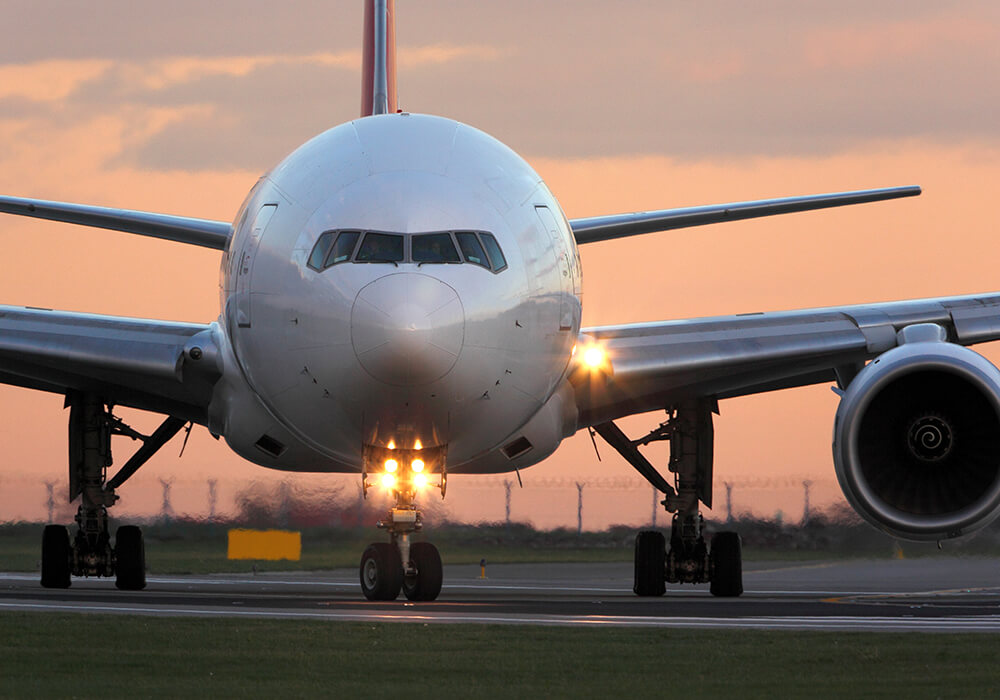
protection. Q.A ROR, utilizing QSuits for total protection from the unknown would have provided them with full protection from the virus during this early stage.
Whilst the economic cost was massive, the cost in human life was even greater and is still increasing today. Limiting the spread of the virus during early days/weeks would have dramatically reduced the strain on healthcare organizations and their ability to manage patient care. It would have provided the pharma industry with valuable time to start vaccine programs that would ultimately reduce in-patient care and death. It is difficult to estimate the reduction in human life a ROR program would have had over the past two years. But a reduction in mortality of at least 20% is plausible. That would be 100,000 Americans and a quarter of a million people Worldwide as at January 2022.
ROR allows decision makers to re-define a lock down. It limits exposure and allows healthcare organizations to cope with smaller volumes of people in the period of ‘not knowing’ the nature and the scale of the challenge.
It protects the economy by allowing people to carry on daily activities including essential services, while only being minimally restricted by wearing Q.Suit protection. Many more shops would be able to stay open. Other sectors of the economy would have a new tool to address the risks and would benefit Schools and Universities, manufacturing, distribution, offices etc. The hardship endured by families barred from visiting senior citizens would be mitigated as families with access to Q.Suits could still be permitted to visit loved ones whilst protected by the suit.
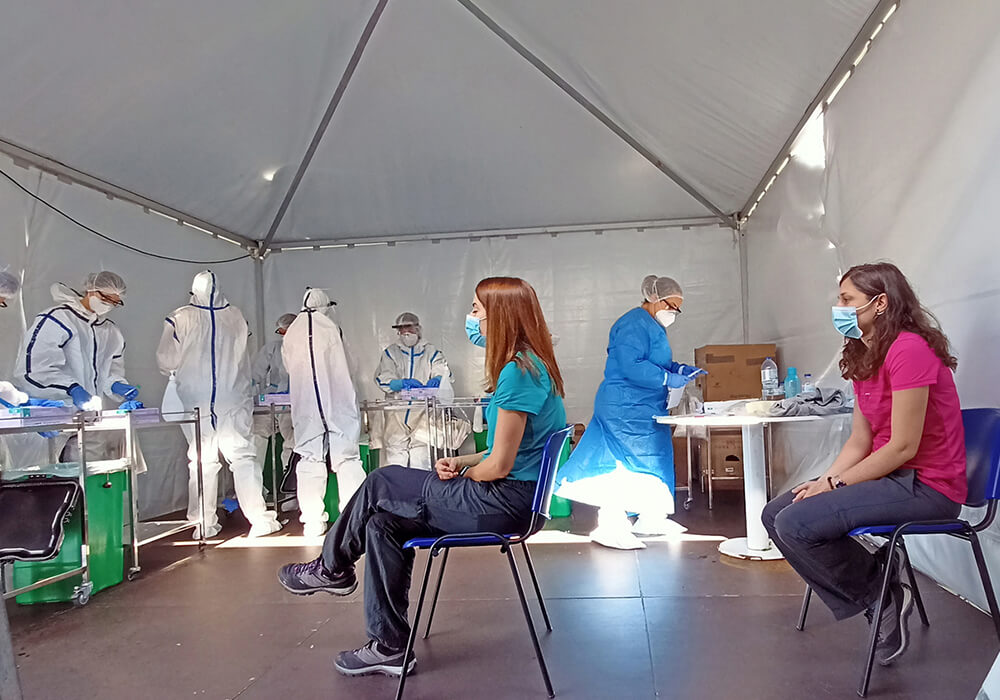
How feasible is the widespread use of Q.Suits? This may have sounded ridiculous two years ago, but now people across the world would be happy to endure the minor discomfort and inconvenience of wearing a Q.Suit in exchange for moments with loved ones and being able to go about normal daily routines knowing they were protected.
The absence of firm policies to contain the spread of virus led to numerous adverse consequences. Extended periods of lock down, daily media updates of hospital admissions and daily death counts that destroyed families and public confidence and trust in our institutions. Public health policies, such as mask wearing, handwashing and vaccination protocols suffer due to this loss of trust. Inappropriate and insufficient PPE convey a lack of respect to doctors and nursing staff. The business community was unable to trust the roadmap for coming out of lockdown. Preparedness is the key to addressing all these adverse effects. Governments and industries that step up and deploy a well-organized
response will be seen as having a deep commitment to protecting people. An aggressive response in the early days of a pandemic will help foster confidence and become the ‘new norm’ for dealing with outbreaks of this type. Governments and industry recognize they cannot fail to take steps to prepare for the next outbreak. Planetary ProTech’s ROR program is an comprehensive, holisitc method of spreading the cost of preparedness.
To discuss the ROR program contact Eugene Grace, CEO Planetary Protech LLC

